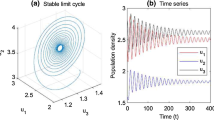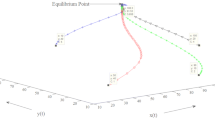Abstract
This paper deals with the spatio-temporal dynamics of a pollinator–plant–herbivore mathematical model. The full model consists of three nonlinear reaction–diffusion–advection equations defined on a rectangular region. In view of analyzing the full model, we firstly consider the temporal dynamics of three homogeneous cases. The first one is a model for a mutualistic interaction (pollinator–plant), later on a sort of predator–prey (plant–herbivore) interaction model is studied. In both cases, the interaction term is described by a Holling response of type II. Finally, by considering that the plant population is the unique feeding source for the herbivores, a mathematical model for the three interacting populations is considered. By incorporating a constant diffusion term into the equations for the pollinators and herbivores, we numerically study the spatiotemporal dynamics of the first two mentioned models. For the full model, a constant diffusion and advection terms are included in the equation for the pollinators. For the resulting model, we sketch the proof of the existence, positiveness, and boundedness of solution for an initial and boundary values problem. In order to see the separated effect of the diffusion and advection terms on the final population distributions, a set of numerical simulations are included. We used homogeneous Dirichlet and Neumann boundary conditions.
Similar content being viewed by others
References
Alt, W. (1985). Models for mutual attraction and aggregation of motile individuals. In Lecture notes in biomathematics (Vol. 57, pp. 33–38).
Arrowsmith, D. K., & Place, C. M. (1998). Dynamical systems. Differential equations, maps, and chaotic behavior. London: Chapman and Hall.
Boucher, D. H. (1982). The biology of mutualism. Oxford: Oxford University Press.
Collings, J. B. (1997). The effect of the functional response on the bifurcation behaviour of a mite predator-prey interaction model. J. Math. Biol., 36, 149–168.
Couzin, I. D., & Krause, J. (2003). Self-organization and collective behaviour in vertebrates. Adv. Study Behav., 32, 1–75.
Crawley, M. J. (1992). Natural enemies: The population biology of predators, parasites, and disease. Oxford: Blackwell Scientific Publications.
García-Ramos, G., Sánchez-Garduño, F., & Maini, P. K. (2000). Dispersal can sharpen parapatric boundaries in a spatially varying environment. Ecology, 81(3), 749–760.
Hanski, I. (1997). Metapopulation dynamics: From concepts and observations to predictive models. In I. A. Hanski & M. E. Gilpin (Eds.), Metapopulation biology (pp. 69–91). San Diego: Academic Press.
Hanski, I. (1999). Metapopulation ecology. New York: Oxford University Press.
Holmes, E. E., Lewis, M. A., Banks, J. E., & Veit, R. R. (1994). Partial differential equations in ecology: Spatial interactions and population. Ecology, 75(1), 17–29.
Jang, S. R. (2002). Dynamics of herbivore-plants-pollinator models. J. Math. Biol., 44, 129–149.
Kierstead, H., & Slobodkin, L. B. (1953). The size of water masses containing plankton blooms. J. Mar. Res., 12, 141–147.
Kot, M. (2001). Elements of mathematical ecology. Cambridge: Cambridge University Press.
Kot, M., & Schaffer, W. M. (1986). Discrete-time growth dispersal models. Math. Biosci., 80, 109–136.
Kuznetsov, Y. A. (2004). Applied mathematical series: Vol. 112. Elements of applied bifurcation theory. Berlin: Springer.
Levin, S. A., & Segel, L. A. (1976). Hypothesis for origin of plantktonic patchiness. Nature, 259, 659.
Malchow, H., Petrovskii, S. V., & Venturino, E. (2007). Spatiotemporal patterns in ecology and epidemiology: Theory, models and simulation. Boca Raton: Chapman and Hall/CRC.
Market, P. A. (2002). Metapopulations. In H. A. Mooney & J. G. Canadell (Eds.), The Earth system: Biological and ecological dimensions of global environmental change (Vol. 2, pp. 411–420). Chichester: Wiley.
May, R. M., & Southwood, T. R. E. (1990). Introduction. In B. Shorrocks & I. R. Swingland (Eds.), Living in a patchy environment (pp. 1–22). Oxford: Oxford University Press.
Mimura, M., Nishiura, Y., & Yamaguti, M. (1979). Some diffusive prey and predator systems and their bifurcation problem. Ann. N.Y. Acad. Sci., 316, 490–510.
Molofsky, J., & Bever, J. D. (2004). A new kind of ecology? Bioscience, 54(5), 440–446.
Muratov, C. B., & Osipov, V. V. (1996). Scenarios of domain patterns in a reaction-diffusion system. Phys. Rev. E, 54, 4860.
Murray, J. D. (2003). Mathematical biology II: Spatial models and biomedical applications. Berlin: Springer.
Okubo, A. (1986). Dynamical aspects of animal grouping: Swarms, schools, and herds. Adv. Biophys., 22, 1–94.
Okubo, A., & Levin, S. A. (2001). Diffusion and ecological problems, modern perspective. Berlin: Springer.
Pao, C. V. (1992). Nonlinear parabolic and elliptic equations. New York: Plenum Press.
Quilantán, I. (2010): Dinámica espacio-temporal de una interacción polinizador-planta-herbívoro. MSc Thesis on Applied Mathematics, DACB, UJAT, México.
Sánchez-Garduño, F. (2001). Continuous density-dependent diffusion modelling in ecology: A review. Recent Res. Ecol., 1, 115–127.
Sánchez-Garduño, F., & Breña-Medina, V. (2010). Existence, positiveness and boundness of solutions in a pollinator-plant-herbivore mathematical model. In preparation.
Sánchez-Garduño, F., Maini, P. K., & Pérez-Velázquez, J. (2010). A nonlinear degenerate equation for direct aggregation and traveling wave dynamics. Discrete Contin. Dyn. Syst., Ser. B, 13(2), 455–487.
Segel, L. A., & Jackson, J. L. (1972). Dissipative structure: An explanation and an ecological example. J. Theor. Biol., 37, 545–559.
Skellam, J. G. (1951). Random dispersal in theoretical populations. Biometrika, 38, 196–218.
Skellam, J. G. (1973). The formulation and interpretation of mathematical models of diffusionary processes in population biology. In M. S. Batchellet et al. (Eds.), The mathematical theory of the dynamics in biological populations. New York: Academic Press.
Soberón, J. M., & Martínez del Río, C. (1981). The dynamics of a plant-pollinator interaction. J. Theor. Biol., 91, 363–378.
Steele, J. H. (1974). Spatial heterogeneity and population stability. Nature, 248, 83.
Turchin, P., & Kareiva, P. (1989). Aggregation in aphis varians: An effective strategy for reducing risk. Ecology, 70(4), 1008–1016.
Turchin, P. (1998). Quantitative analysis of movement: Population redistribution in animals and plants. Sunderland: Sinauer.
Turing, A. M. (1952). The chemical basis of morphogenesis. Philos. Trans. R. Soc. Lond. B, 237, 37–72.
Velázquez, G. (2008) Dinámica temporal de una interacción polinizador-planta-herbívoro. MSc Thesis on Applied Mathematics, DACB, UJAT, México.
Author information
Authors and Affiliations
Corresponding author
Rights and permissions
About this article
Cite this article
Sánchez-Garduño, F., Breña-Medina, V.F. Searching for Spatial Patterns in a Pollinator–Plant–Herbivore Mathematical Model. Bull Math Biol 73, 1118–1153 (2011). https://doi.org/10.1007/s11538-010-9599-z
Received:
Accepted:
Published:
Issue Date:
DOI: https://doi.org/10.1007/s11538-010-9599-z




